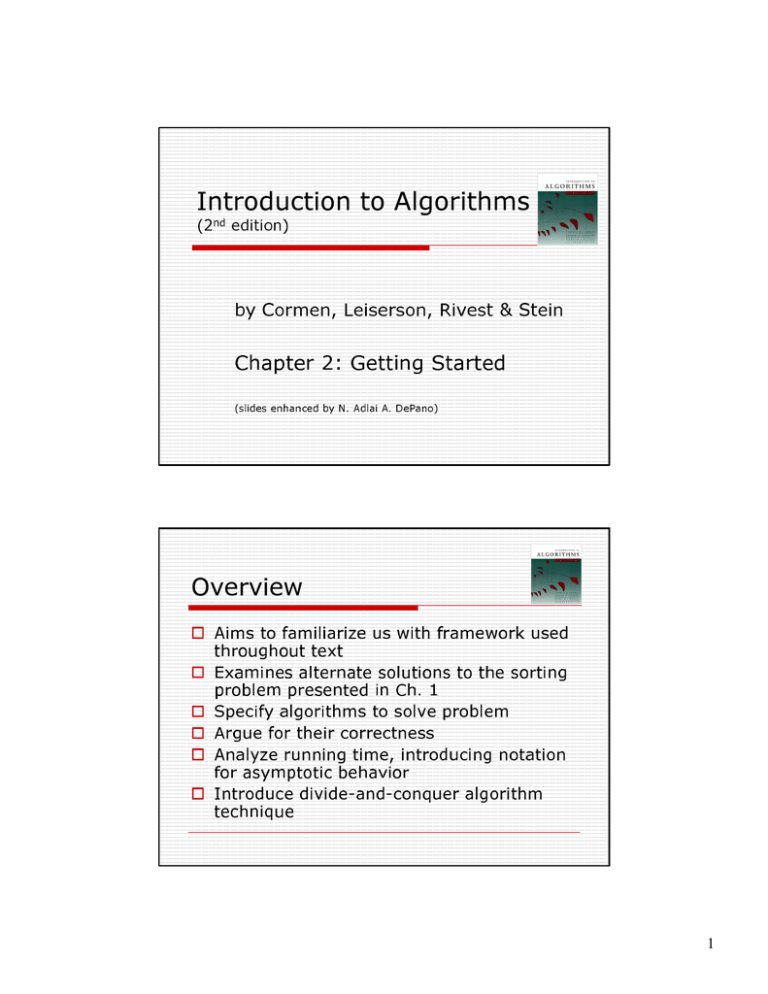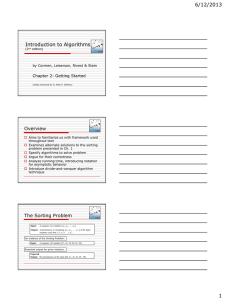Introduction to Algorithms Chapter 2: Getting Started
advertisement

Introduction to Algorithms (2nd edition) by Cormen, Leiserson, Rivest & Stein Chapter 2: Getting Started (slides enhanced by N. Adlai A. DePano) Overview Aims to familiarize us with framework used throughout text Examines alternate solutions to the sorting problem presented in Ch. 1 Specify algorithms to solve problem Argue for their correctness Analyze running time, introducing notation for asymptotic behavior Introduce divide-and-conquer algorithm technique 1 The Sorting Problem Input: A sequence of n numbers [a1, a2, … , an]. Output: A permutation or reordering [a'1, a'2, … , a'n ] of the input sequence such that a'1 ≤ a'2 ≤ … ≤ a'n . An instance of the Sorting Problem: Input: A sequence of 6 number [31, 41, 59, 26, 41, 58]. Expected output for given instance: Expected Output: The permutation of the input [26, 31, 41, 41, 58 , 59]. Copyright © The McGraw-Hill Companies, Inc. Permission required for reproduction or display. Insertion Sort The main idea … 2 Copyright © The McGraw-Hill Companies, Inc. Permission required for reproduction or display. Insertion Sort (cont.) Copyright © The McGraw-Hill Companies, Inc. Permission required for reproduction or display. Insertion Sort (cont.) 3 Copyright © The McGraw-Hill Companies, Inc. Permission required for reproduction or display. Insertion Sort (cont.) The algorithm … Loop Invariant Property of A[1 .. j − 1] At the start of each iteration of the for loop of lines 1− 8, the subarray A[1 .. j − 1] consists of the elements originally in A[1 .. j − 1] but in sorted order. Need to establish the following re invariant: Initialization: true prior to first iteration Maintenance: if true before iteration, remains Termination: true after iteration at loop termination, invariant implies correctness of algorithm 4 Analyzing Algorithms Has come to mean predicting the resources that the algorithm requires Usually computational time is resource of primary importance Aims to identify best choice among several alternate algorithms Requires an agreed-upon “model” of computation Shall use a generic, one-processor, random-access machine (RAM) model of computation Random-Access Machine Instructions are executed one after another (no concurrency) Admits commonly found instructions in “real” computers, data movement operations, control mechanism Uses common data types (integer and float) Other properties discussed as needed Care must be taken since model of computation has great implications on resulting analysis 5 Analysis of Insertion Sort Time resource requirement depends on input size depends on problem being studied; frequently, this is the number of items in the input Running time: number of primitive operations or “steps” executed for an input Assume constant amount of time for each line of pseudocode Input size Copyright © The McGraw-Hill Companies, Inc. Permission required for reproduction or display. Analysis of Insertion Sort Time efficiency analysis … 6


